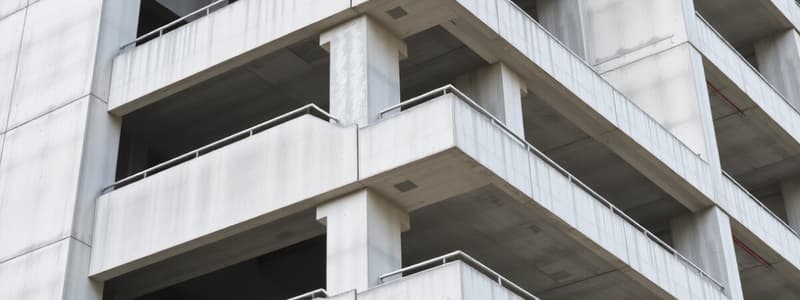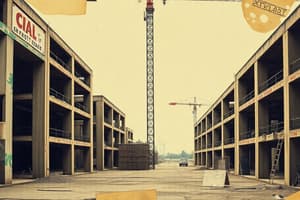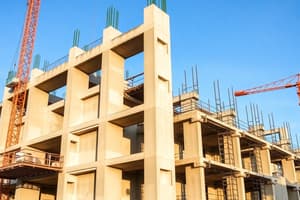Podcast
Questions and Answers
Precast concrete is created by pouring concrete into a pre-shaped ______.
Precast concrete is created by pouring concrete into a pre-shaped ______.
mold
Once cured, the mold is removed and can be ______ for future use.
Once cured, the mold is removed and can be ______ for future use.
reused
Typical uses of precast concrete include walls, floors, beams, ______, and modules.
Typical uses of precast concrete include walls, floors, beams, ______, and modules.
columns
Cast in place concrete requires more time due to the need for ______ and space.
Cast in place concrete requires more time due to the need for ______ and space.
Precast concrete offers better quality control due to its controlled production ______.
Precast concrete offers better quality control due to its controlled production ______.
The labor efficiency of precast concrete is higher because it requires less skilled ______.
The labor efficiency of precast concrete is higher because it requires less skilled ______.
Curing conditions for precast concrete are factory-controlled, which allows for ______ of production time.
Curing conditions for precast concrete are factory-controlled, which allows for ______ of production time.
Cast in place concrete can take ______ days to reach full strength.
Cast in place concrete can take ______ days to reach full strength.
Precast concrete reduces overall ______ during the construction process.
Precast concrete reduces overall ______ during the construction process.
Higher labor costs and overheads are associated with the ______ process of casting in place concrete.
Higher labor costs and overheads are associated with the ______ process of casting in place concrete.
An unexpected ______ can grind on-site casting work to a halt.
An unexpected ______ can grind on-site casting work to a halt.
Precast concrete requires ______ conditions for it to be cost-effective.
Precast concrete requires ______ conditions for it to be cost-effective.
Cast in place concrete structures have ______ variability.
Cast in place concrete structures have ______ variability.
Precast concrete systems are beneficial for projects with ______ elements.
Precast concrete systems are beneficial for projects with ______ elements.
In cast in place concrete, there is less use of ______ equipment.
In cast in place concrete, there is less use of ______ equipment.
Joints in precast concrete systems are considered a ______ component.
Joints in precast concrete systems are considered a ______ component.
Precast concrete has a ______ environmental impact compared to cast in place concrete.
Precast concrete has a ______ environmental impact compared to cast in place concrete.
Casting in place concrete usually involves ______ projects.
Casting in place concrete usually involves ______ projects.
Precast systems require less ______ due to better molding conditions.
Precast systems require less ______ due to better molding conditions.
Contractors for precast systems are usually more ______ than those for cast in place systems.
Contractors for precast systems are usually more ______ than those for cast in place systems.
Flashcards
Cast-in-Place Concrete
Cast-in-Place Concrete
A construction method where concrete is poured and hardened on-site, allowing for unique shapes but potential delays due to weather.
Precast Concrete
Precast Concrete
A construction method where concrete is formed and cured off-site, then transported and assembled, leading to faster construction but more planning for transportation.
When to use Precast Concrete
When to use Precast Concrete
Using precast concrete is advantageous in projects with repeating structural elements, larger scales, and suitable site conditions.
When to use Cast-in-Place Concrete
When to use Cast-in-Place Concrete
Signup and view all the flashcards
Cost Comparison: Precast vs. Cast-in-Place
Cost Comparison: Precast vs. Cast-in-Place
Signup and view all the flashcards
Cost Comparison: Cast-in-Place vs. Precast
Cost Comparison: Cast-in-Place vs. Precast
Signup and view all the flashcards
Handling: Cast-in-Place vs. Precast
Handling: Cast-in-Place vs. Precast
Signup and view all the flashcards
Handling: Precast vs. Cast-in-Place
Handling: Precast vs. Cast-in-Place
Signup and view all the flashcards
Joints: Cast-in-Place vs. Precast
Joints: Cast-in-Place vs. Precast
Signup and view all the flashcards
Joints: Precast vs. Cast-in-Place
Joints: Precast vs. Cast-in-Place
Signup and view all the flashcards
What is precast concrete?
What is precast concrete?
Signup and view all the flashcards
Components of a precast concrete system
Components of a precast concrete system
Signup and view all the flashcards
Considerations for precast concrete systems
Considerations for precast concrete systems
Signup and view all the flashcards
Cast-in-place vs. Precast concrete
Cast-in-place vs. Precast concrete
Signup and view all the flashcards
Casting time in cast-in-place vs. precast concrete
Casting time in cast-in-place vs. precast concrete
Signup and view all the flashcards
Quality control in cast-in-place vs. precast concrete
Quality control in cast-in-place vs. precast concrete
Signup and view all the flashcards
Labor efficiency in cast-in-place vs. precast concrete
Labor efficiency in cast-in-place vs. precast concrete
Signup and view all the flashcards
Construction speed in cast-in-place vs. precast concrete
Construction speed in cast-in-place vs. precast concrete
Signup and view all the flashcards
Curing conditions in cast-in-place vs. precast concrete
Curing conditions in cast-in-place vs. precast concrete
Signup and view all the flashcards
Efficiency of precast concrete construction
Efficiency of precast concrete construction
Signup and view all the flashcards
Study Notes
Alternative Building Construction Systems
- Precast concrete is a construction material made by pouring concrete into a pre-shaped mold.
- The concrete cures in an appropriate environment.
- The mold is removed and reused.
- The precast concrete product is then taken to the job site and used for the project.
Typical Uses of Precast Concrete
- Walls
- Floors
- Beams
- Columns
- Stairs
- Modules
Precast Concrete vs. Cast-in-Place Concrete
| Feature | Cast-in-Place | Precast |
|---|---|---|
| Casting | Waiting time is longer; labor and space required for on-site casting | Ready for immediate placement on site |
| Quality Control | More susceptible to quality issues due to workmanship errors | Better quality due to controlled production environment (e.g., water-cement ratio) |
| Labor Efficiency | Involves manual labor, increasing costs and overheads | Less need for skilled labor, easier assembly leading to lower man-hours |
| Speed of Construction | Time-consuming process (28 days to reach full strength waiting) | Faster; less waiting time for full strength; less falsework |
| Curing Conditions | Concrete needs 7 more days to cure before placement or connection with previous parts | Factory-controlled curing conditions; workers can speed up curing while maintaining quality |
| Weather Conditions | Unexpected rain halts on-site casting | Rain does not disrupt installation; contractor can still lift into place |
| Economy | Higher costs and material waste | Lower cost (especially in labor and raw materials) |
| Formwork | Good for customized structural elements | Good for repetitive structural elements |
| Handling | Less use of heavy equipment | Reliance on heavy equipment and machinery |
| Joints | Less joints; mostly monolithic | Joints are critical system components that need design attention |
| Earthquake Resilience | Resilient | Resilient |
| Contractor | Generic | Specialized |
| Environmental Impact | Higher negative impact due to construction waste | Lesser impact; some materials can be reused or easily disassembled |
| Plastering | Needs plastering | Less plastering required due to better molding conditions |
When to Use Precast Concrete
- Projects with repetitive elements
- Large projects with long spans
- Ideal sites and logistics conditions
When to Use Cast-in-Place Concrete
- Structures with high variability
- Smaller projects
- Sites with limited access or logistics issues
Studying That Suits You
Use AI to generate personalized quizzes and flashcards to suit your learning preferences.




